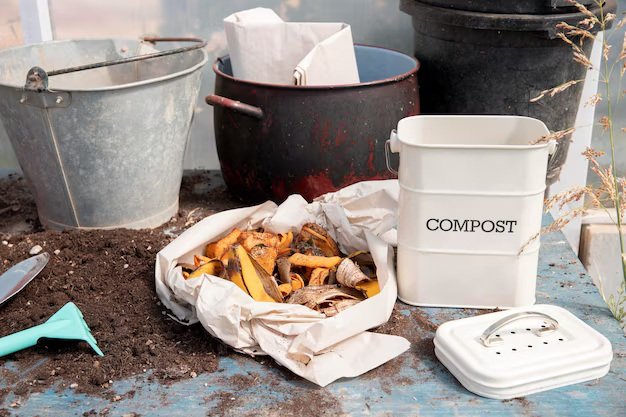Can You Compost Rice and Pasta?
If you’ve ever hesitated over your compost bin, wondering whether to toss in leftover rice or pasta, you’re not alone. I’ve been there too, staring at my plate, questioning whether these starchy leftovers will help my compost thrive or turn it into a soggy mess. Composting is a fantastic way to cut down on food waste and enrich soil, but some foods—especially cooked ones—come with extra challenges.
Rice and pasta have a bit of a bad reputation in composting circles. Some say they break down just fine, while others warn about mould, pests, and slow decomposition. The truth? Yes, you can compost them, but you need to do it the right way.
The key is balance. Add small amounts, mix them with dry materials like leaves or paper, and make sure your compost gets enough air. Otherwise, you might end up with clumpy, smelly, or pest-attracting waste. But when done correctly, these starchy foods break down beautifully, adding nutrients to your soil.
So don’t stress over that leftover pasta—just compost smart! This guide will walk you through everything you need to know to do it safely and effectively. Let’s get started.

In This Article
- Understanding the Basics: How Composting Works
- The Challenges of Composting Rice and Pasta
- How to Compost Rice and Pasta the Right Way
- Expert Insights: What Do Composting Specialists Say?
- Research and Studies on Composting Starchy Foods
- Common Myths About Composting Rice and Pasta
- Actionable Tips: Making Rice and Pasta Composting Work for You
- Conclusion: Composting Rice and Pasta is Possible—With the Right Approach
Understanding the Basics: How Composting Works
Composting is nature’s way of recycling. It’s how organic waste—like food scraps and yard waste—breaks down into rich, healthy soil with the help of tiny organisms like bacteria, fungi, and insects. Instead of throwing leftovers in the trash, composting gives them a second life by turning them into nutrient-packed humus that improves soil and helps plants grow.
A good compost pile needs a balance of:
- Greens (Nitrogen-rich materials): These include fruit and veggie scraps, coffee grounds, and food waste. They provide protein for microorganisms to thrive.
- Browns (Carbon-rich materials): Dry leaves, shredded paper, and wood chips add structure and absorb moisture.
- Moisture: Compost should be damp, like a wrung-out sponge. Too dry, and it won’t break down; too wet, and it gets slimy.
- Aeration: Turning the pile keeps oxygen flowing, helping materials break down faster and preventing bad odours.
Rice and pasta belong to the greens category because they’re high in nitrogen, but they can be tricky. They clump together, attract pests, and grow mould if not composted properly. With the right balance and care, though, they can break down just like any other food scrap.
The Challenges of Composting Rice and Pasta
Composting rice and pasta sounds simple; however, if you’ve ever tried it, you might have noticed some problems, like mould, pests, or a slow breakdown. Let’s talk about why these issues happen and how to avoid them.
1. Mould and Spoilage
Cooked rice and pasta hold onto moisture, which is great for microbes but also perfect for mould and anaerobic bacteria. If you’ve ever left rice sitting in a container too long, you know the smell! The same thing happens in compost if there’s too much moisture and not enough airflow. Instead of healthy decomposition, you get a slimy, smelly mess.
2. Pests and Rodents
Uncooked rice and pasta attract critters looking for an easy meal. Cooked versions, especially those with sauce or butter, are even worse. The fats and seasonings make your compost bin a five-star restaurant for rodents and insects. If you’re using an open pile, this can quickly turn into a pest problem.
3. Clumping and Slow Breakdown
Ever noticed how rice and pasta stick together in a clump? That’s exactly what happens in your compost. These starchy foods can create dense pockets that block airflow, slowing down decomposition. Instead of breaking down into rich compost, they form soggy, compacted lumps.
The good news? With a little care—like balancing with dry materials, turning the pile, and burying food scraps—you can compost rice and pasta without these headaches!
Learn More: Are Orbeez Biodegradable?
How to Compost Rice and Pasta the Right Way

1. Balance the Carbon-to-Nitrogen Ratio
Rice and pasta are high in nitrogen, which is great for composting, but too much can make your pile soggy and smelly. The fix? Balance them with “browns” like dried leaves, shredded newspaper, or cardboard. A simple rule: for every scoop of rice or pasta, mix in three times as much carbon-rich material. This keeps things airy and prevents unpleasant odours.
2. Avoid Large Quantities at Once
A small portion of rice or pasta? That’s fine. But dumping a whole pot into your compost bin? That’s a recipe for problems. Large amounts clump together, making it harder for air to circulate. Instead, add rice and pasta in small batches, allowing the pile to stay balanced.
3. Bury It Under Browns
Rodents and insects love exposed food scraps. To keep pests away, always bury rice and pasta under a thick layer of dry leaves, sawdust, or shredded paper. This also helps absorb extra moisture, preventing mould from forming.
4. Turn the Pile Regularly
Good compost needs oxygen. Turning your pile once a week helps break up clumps, speeds up decomposition, and prevents slimy, stinky pockets from forming.
5. Use a Hot Composting System
Hot composting (130°F–160°F) breaks down food waste quickly and kills harmful bacteria. If you compost rice and pasta, keeping your pile hot ensures a faster, safer process.
6. Consider Bokashi Composting
If you’re dealing with a lot of cooked food waste, Bokashi composting is a game-changer. This method ferments food scraps, making it easier to compost even tricky items like rice and pasta.
By following these steps, you can safely compost rice and pasta while keeping your compost pile healthy and productive.
Expert Insights: What Do Composting Specialists Say?
When it comes to composting rice and pasta, the experts agree—it’s completely doable, but technique matters.
Dr. Linda Chalker-Scott, an extension urban horticulturist and associate professor at Washington State University, provides guidance on composting starchy foods:
“Bread products, including cakes, rice, pasta, and most baked goods can absolutely be composted, but the key is how you do it. In aerobic composting systems, these foods should be introduced in moderation with sufficient aeration. If using anaerobic systems like Bokashi, they break down even faster.”
Her advice highlights a crucial point—proper airflow prevents mould and unwanted smells, while alternative methods like Bokashi make composting even easier.
Mark Lively, a sustainable gardener, shares his real-world experience:
“I used to avoid composting rice and pasta because of pests. Then I started mixing them with sawdust and coffee grounds before adding them to my pile. No more issues, and my compost is thriving!”
Mark’s simple fix—layering dry materials—shows how small changes make a big difference. By following expert advice and making a few tweaks, rice and pasta can be composted safely, keeping waste out of landfills and turning scraps into nutrient-rich soil.
Research and Studies on Composting Starchy Foods
Researchers at the University of Vermont’s Waste Reduction Program studied how starchy foods break down in composting systems. Their findings? Rice and pasta can successfully decompose when paired with enough carbon materials—like dry leaves or shredded paper—and given proper aeration. This means if you mix these foods into your compost pile the right way, they won’t turn into a mouldy mess.
Another key takeaway from the study is that high temperatures speed up the process. In hot composting systems (where temperatures reach 140°F or more), rice and pasta break down in as little as two to four weeks. In cooler composting conditions, the process can take two to six months. Bokashi composting—an anaerobic method—ferments rice and pasta within two weeks, after which it further breaks down in the soil. However, worms aren’t big fans of starch-heavy foods, so vermicomposting isn’t ideal for these leftovers.
Estimated Breakdown Time for Rice and Pasta
| Composting Method | Estimated Breakdown Time |
|---|---|
| Hot Composting (140°F+) | 2-4 weeks |
| Cold Composting | 2-6 months |
| Bokashi Composting | 2 weeks (pre-fermentation), 4-6 weeks in soil |
| Vermicomposting (Worm Bins) | Not recommended |
Learn More: Biodegradable vs. Compostable
Common Myths About Composting Rice and Pasta
1. “You Can’t Compost Rice Because It Ferments”
This one is partly true—if you leave rice in a closed, airless space, it can ferment and smell bad. But composting isn’t about letting food rot in a pile. When done right, composting uses oxygen and helpful microbes to break things down. Mixing rice with dry materials like leaves or cardboard and turning the pile regularly prevents fermentation.
2. “Pasta Attracts Rodents, So It Should Be Avoided”
Rodents love exposed food, but the solution is simple: bury it. If you mix pasta deep into your compost and cover it with dry materials, there’s nothing to attract pests. Sealed compost bins also keep unwanted visitors out.
3. “Rice and Pasta Take Too Long to Break Down”
It depends on your composting method. In a slow, cold compost pile, rice and pasta can take a while. But in a hot compost system (where temperatures stay above 130°F), they break down as quickly as fruit and vegetable scraps.
Case Study: Urban Composting Success in East London
During the COVID-19 lockdowns, Anthony Ussher and his neighbour Helenka transformed a small garden in East London into a thriving community space. They started composting organic waste from their own kitchens and nearby restaurants, but initially avoided certain foods—like rice and pasta—due to concerns about mould and pests.
However, after researching alternative composting techniques, they discovered that fermentation composting (also known as Bokashi composting) could safely break down starchy foods. By layering cooked rice and pasta with Bokashi bran in an airtight bin, they were able to ferment these materials rather than letting them rot. After two weeks, the pre-composted mixture was transferred to their soil beds, where it broke down completely, enriching the garden’s soil without attracting pests.
This method not only helped them reduce waste from local restaurants but also demonstrated a scalable way to compost tricky food scraps in an urban environment. Their initiative, City Soil Lab, later gained support from the Tower Hamlets Council as a model for sustainable composting in cities.
Actionable Tips: Making Rice and Pasta Composting Work for You
1. Use a Hot Composting System for Outdoor Composting
If you’re composting outdoors, keeping your pile hot (above 130°F) is key. High temperatures help break down rice and pasta quickly while preventing mould and bacteria from taking over. To avoid attracting rodents, always bury rice and pasta under “brown” materials like dry leaves, sawdust, or shredded newspaper. This keeps them hidden while also balancing moisture levels.
2. Consider Bokashi or a Sealed Tumbler for Indoor Composting
If you compost indoors, a Bokashi bin is a great option. This fermentation-based system can handle all kinds of food scraps, including rice and pasta. A sealed tumbler composter is another good choice, as it keeps pests away and maintains proper aeration.
3. Use Rice and Pasta in Moderation
Rice and pasta are high in nitrogen, which is great for composting, but too much at once can throw off the balance. A simple rule: for every handful of rice or pasta, add three handfuls of dry materials to keep things from getting too wet and sticky.
4. Keep an Eye on Moisture Levels
If your compost is too wet, mould can grow. If it’s too dry, decomposition slows down. Make sure your pile feels like a damp sponge—moist but not soggy. If it’s too wet, add more dry materials; if it’s too dry, sprinkle in a little water.
5. Start Small and Adjust as Needed
Not sure how your compost pile will react? Test with small amounts first and see how it breaks down. If everything goes smoothly, you can gradually add more over time.
Conclusion: Composting Rice and Pasta is Possible—With the Right Approach
Rice and pasta might not be the first things that come to mind when composting, but with a little care, they can be valuable additions to your compost pile. By balancing carbon-to-nitrogen ratios, maintaining aeration, and using proper techniques, you can turn these starchy leftovers into nutrient-rich compost, helping both your garden and the planet.
So next time you scrape some leftover rice into the trash, stop and think: could it be better used in your compost instead? The answer is likely yes—just compost smart!







